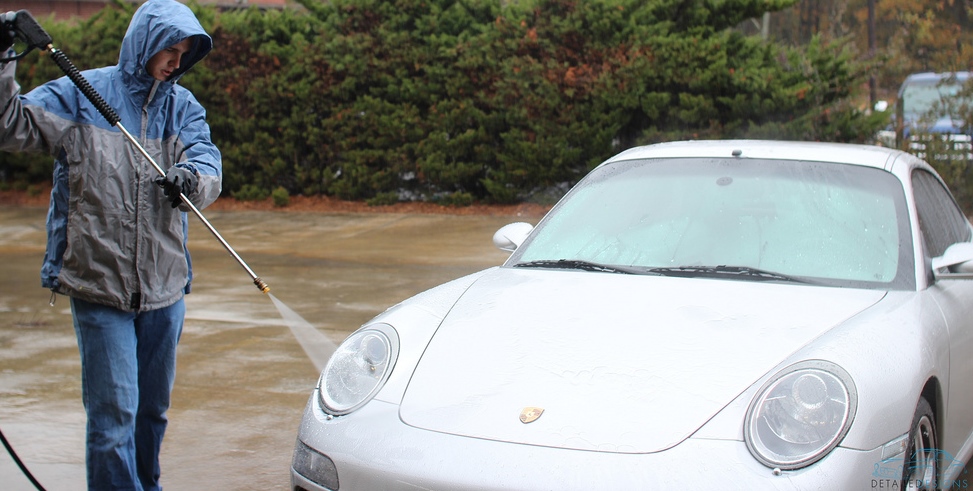I have literally no idea how many times folks have asked me how I can detail a car in the winter time. At the same time folks have asked me, how THEY can detail their car in the winter time. My answer is always the same, the right clothing and gear can either make your detailing and washes pleasant, or the lack thereof can mean you don’t touch your car until it is warm again. I know that detailing cars in Atlanta isn’t exactly the worst possible weather for the winter months, but having detailed in 33 degree weather with success, I think you’ll agree that some things are universal.
Everyone is different in what causes us discomfort. For me, when it’s cold out, I need a warm neck, dry/warm hands and dry feet. To begin, you should think about the gaps in your “armor”. What causes you discomfort? Those should be focal points when preparing the clothing and gear needed.
Why does wetness on our bodies cause extra discomfort while it’s cold? According to the Centers for Disease Control and Prevention, water conducts heat away from a human body 25 times quicker than air. If we are to stay comfortable in the cold weather while washing, staying dry is necessary.
Typically, the areas that get wet are going to be your hands, sleeves and feet. If working with someone else while washing, someone may get exposed to a stream of water from a rinser/helper. What we will discuss are these typical areas of exposure.
There are literally countless options for footwear. But before you purchase footwear for washing, it’s important to understand how water can find its way inside a shoe. There are two main ways water finds its way inside a shoe; wicking and outright passing through fabric. Just like if you were to hold a sheet of paper half way submerged in water and water wicks up above the water level, a shoe can wick water from a rubber sole up the exterior. I enjoy wearing shoes with minimal sole. But I understand that come winter time I need to wear something with a more substantial sole. If you’re standing in a puddle of water in something with low-profile sole, you’re more likely to have the water level go above the sole or it quickly reaches the fabric or leather uppers and soaks through.
If you have a thick rubber sole and a waterproof upper, you will have dry feet. Personally, I find that a good leather boot with a thick sole provides me with dry feet. The boots I use are not water-proof but because we literally are not standing in 1′ deep water, I don’t find water-proof shoes a must.
If your shoes have mesh uppers, water and wind will pass right through. In my opinion, leave the mesh shoes in the closet until Spring.
Moving up, most folks like toasty warm legs while working in really cold weather. Long johns under chinos, blue jeans or khakis keep legs warm and gives me a little more shield from the outer wear moisture reaching the skin.
Everyone that is serious about detailing in the winter should have a rain jacket or at least a jacket that repels water and moisture well. Personally, knowing that my neck is my real weak link in my upper body means I wear a jacket with a long neck opening. One blast of cold air sends chills all over and if I am going to stay sharp and focus on the project at hand, I need it covered up.
A rain jacket keeps Tim, a tech at Detailed Designs Auto Spa, dry in his time of need
Good body coverage is necessary for keeping the cold wind off your skin
I find there is one major requirement for my rubber gloves. A glove that has a long cuff. Why is a long cuff necessary? When you dip your hand into a bucket of water, it can slosh onto your exposed sleeve and water typically runs down the arm when washing(especially the roof areas). A long cuff that can be stretched over your sleeve means you don’t have exposed skin. The biggest drawback to using a long cuffed glove is that putting them on can be a bit of a pain though.
Ensure your gloves cover over your outer wear to limit water getting under your clothes
If you’re so inclined, throw a beanie/sock hot/skull hat on your noggin’ and you’re going to be completely buttoned up from the elements.
While working inside the vehicle there are two keys to keeping warm while working. If the vehicle is outside, you may leave a vehicle running and the heat on. If that is not an option, you can wear some surgical gloves. Surgical gloves will give you more feel for the technical aspects of an interior detail while keeping chemicals off your hands.
Not to be neglected would be the need for proper tools. You can get by with the same tools you use in the summer. Just don’t skimp on the stuff that makes life easier like deep access wheel cleaning tools, excellent chemicals and drying options (leaf blowers don’t work very well when you don’t have evaporative heat).
When working in cold temperatures, keeping dry is going to be the most important factor in keep comfortable. This may seem like common sense kind of stuff, but people have expressed grief over their inability to take care of their automobiles while it’s very cold/windy out. When I ask them what they wear they express that it’s their normal cold weather wear. It’s that little bit (or more) of moisture that is causing their discomfort and hurting their quality because they feel the need to rush. By spending a bit more time thinking about and adjusting what we wear in cold weather all of us can see an improvement in our endurance and the end result.
